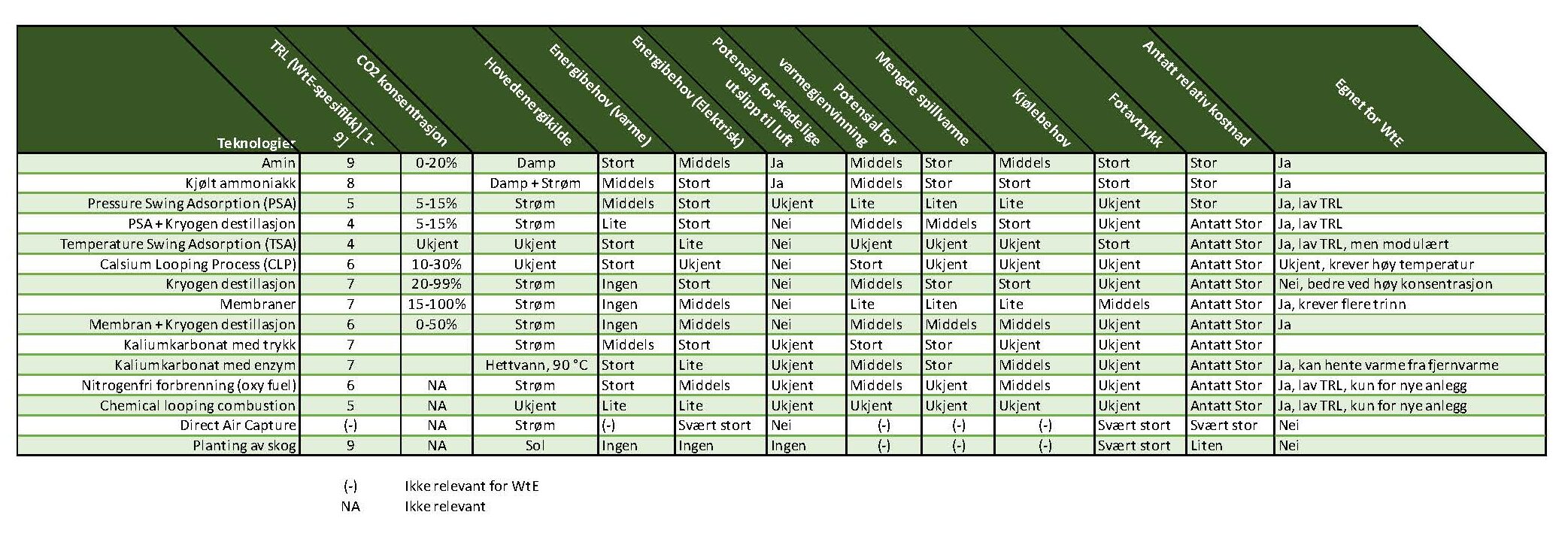Chapter 2
Summing up technologies
Chapter 2
Differences between waste incineration plants significantly affect the choice of capture technology and the supplier of capture plants. It is therefore not possible to give an answer as to which technology or supplier is best suited for use in waste incineration CCS. What is possible, however, is to point out which factors benefit which technologies.

Waste incineration with available heat in the form of steam
Waste incineration with available heat in the form of steam If the intention is to install a capture plant today at a plant, with some available residual heat in the form of steam and the normal cost of electricity with the lowest possible project risk, it is difficult to conclude anything other than an amine-based solution from one of the major experienced players. This is technology that has been proven over time at many different emission points, and most challenges are both known and solved. It is also the only capture technology that can be said to have an established and functioning global market.
When it comes to choosing a supplier, one can choose to go directly to established capture suppliers such as Aker Carbon Capture, Mitsubishi Heavy Industries or Shell Cansolv. There is also an option to go to an EPC supplier who supplies under license for one of these, such as Kanfa (Cansolv). Of these, there are many. Furthermore, there are companies that handle the project as an intermediary between customer and supplier and help simplify the process for the end customer, such as Carbon Centric (Kanfa/Cansolv etc.). The companies mentioned here are examples with experience, and there are good alternatives to them. There are also other technologies that can be said to be safe choices today, but which nevertheless have somewhat less prevalence and experience.
Whether the purpose is a small plant, a plant sometime in the future, one is willing to take more risk, wants to take part in development or support schemes, lacks available residual heat and/or has very reasonable access to electricity, other technologies and suppliers may be favorable choices.
Waste incineration with available heat in the form of hot water
Under these assumptions, the potassium carbonate solution with enzyme as catalyst used by Saipem CO2-Solutions may seem promising. With temperature requirements between 40 and 90 °C, it is conceivable that this solution can operate as a consumer on the district heating network. The solution has been tested at Klemetsrud.
For waste incineration without available heat, but reasonable access to electricity
An example worth mentioning with these pre-deposits is a combination of membrane and cryogenic distillation. The membrane prioritizes CO2 over N2 with a ratio of typically 1:50, and consequently several steps are needed to reach sufficient concentration of CO2. It is a solution that only requires a modest absolute pressure difference at moderate pressures, so in itself it would be a very competitive technology if two or more steps were not required. Cryogenic distillation therein is very energy-intensive if you need to cool the entire flue gas quantity but becomes more and more competitive the less the total amount to be cooled per part of CO2. So, after the first step with membrane there will be very high concentration CO2 compared to flue gas, cryogenic distillation is then a far less energy-intensive process that achieves very high concentration.
Both technologies mainly require some electricity and little heat. The combination is therefore assumed to be a very good solution in absence of heat, but with access to affordable electricity. So for most waste incineration plants in Norway it may not be a good candidate, but in certain plants and for other industries this can be a solution that can provide very beneficial operation. It is not yet known to have been executed on any industrial scale, but the potential of the solution seems promising.